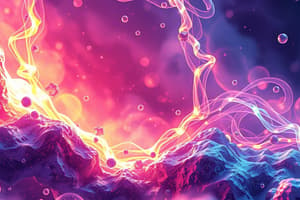Podcast
Questions and Answers
Which of the following best describes thermodynamics?
Which of the following best describes thermodynamics?
- Study of energy changes in chemical reactions (correct)
- Study of the structure of carbon-containing compounds
- Study of the physical properties of substances
- Study of reaction rates
Stereochemistry deals solely with the physical properties of substances.
Stereochemistry deals solely with the physical properties of substances.
False (B)
What is the principle that explains how a system at equilibrium responds to changes in concentration, temperature, or pressure?
What is the principle that explains how a system at equilibrium responds to changes in concentration, temperature, or pressure?
Le Chatelier's Principle
The three types of hydrocarbons include alkanes, alkenes, and _____ .
The three types of hydrocarbons include alkanes, alkenes, and _____ .
Match the following types of organic reactions with their descriptions:
Match the following types of organic reactions with their descriptions:
Flashcards are hidden until you start studying
Study Notes
Chemistry
Physical Chemistry
- Definition: Branch of chemistry that deals with the physical properties and changes of substances.
- Key Concepts:
- Thermodynamics: Study of energy changes in chemical reactions.
- Laws of thermodynamics (e.g., conservation of energy)
- Enthalpy, entropy, and free energy concepts.
- Chemical Kinetics: Investigates the rates of chemical reactions.
- Factors affecting reaction rates: concentration, temperature, catalysts.
- Rate laws and mechanisms.
- Quantum Chemistry: Application of quantum mechanics to chemical systems.
- Wave functions and the Schrödinger equation.
- Electron configurations and atomic orbitals.
- Equilibrium: The state where reactants and products are formed at the same rate.
- Le Chatelier's Principle.
- Equilibrium constants (Kc, Kp).
- Statistical Mechanics: Relates macroscopic properties to microscopic behaviors of particles.
- Thermodynamics: Study of energy changes in chemical reactions.
Organic Chemistry
- Definition: Study of the structure, properties, composition, reactions, and synthesis of carbon-containing compounds.
- Key Concepts:
- Hydrocarbons: Compounds consisting only of carbon and hydrogen.
- Types: Alkanes (single bonds), alkenes (double bonds), alkynes (triple bonds).
- Functional Groups: Specific groups of atoms that impart characteristic properties.
- Examples: Alcohols (-OH), carboxylic acids (-COOH), amines (-NH2), et al.
- Stereochemistry: Study of spatial arrangement of atoms.
- Isomers: Structural isomers and stereoisomers (geometric and optical).
- Reaction Mechanisms: Detailed steps of how reactants transform into products.
- Types: Nucleophilic substitution, electrophilic addition, elimination reactions.
- Biomolecules: Organic molecules essential for life (proteins, carbohydrates, lipids, nucleic acids).
- Hydrocarbons: Compounds consisting only of carbon and hydrogen.
- Laboratory Techniques:
- Spectroscopy (NMR, IR, UV-Vis) for structure determination.
- Chromatography (TLC, HPLC) for separation and purification.
Physical Chemistry
- Deals with the physical properties and changes of substances
- Focuses on energy changes in chemical reactions, rates of chemical reactions, and the application of quantum mechanics to chemical systems.
- Thermodynamics deals with energy changes in chemical reactions including enthalpy, entropy, and free energy
- Chemical kinetics investigates the rates of chemical reactions and factors that affect them such as concentration, temperature, and catalysts
- Quantum chemistry applies quantum mechanics to chemical systems, focusing on electron configurations, atomic orbitals, and wave functions.
- Equilibrium is the state where reactants and products form at equal rates
- Statistical mechanics involves the connection of macroscopic properties to microscopic behaviors of particles.
Organic Chemistry
- Studies the structure, properties, composition, reactions, and synthesis of carbon-containing compounds
- Focuses on hydrocarbons (compounds with only carbon and hydrogen)
- Functional groups are specific groups of atoms that give compounds characteristic properties
- Stereochemistry is the study of the spatial arrangement of atoms in molecules
- Reaction Mechanisms include the detailed steps of how reactants transform into products
- Organic molecules essential to life such as proteins, carbohydrates, lipids, and nucleic acids are known as biomolecules
- Spectroscopy techniques like NMR, IR, and UV-Vis help in determining the structure of molecules
- Chromatography techniques such as TLC and HPLC are used for separation and purification of organic compounds.
Studying That Suits You
Use AI to generate personalized quizzes and flashcards to suit your learning preferences.




